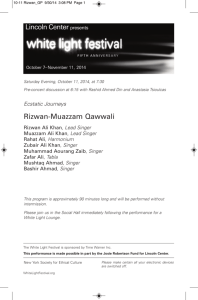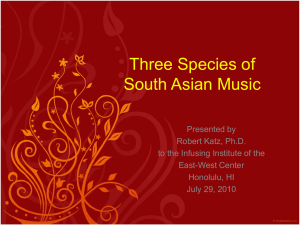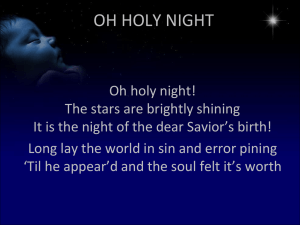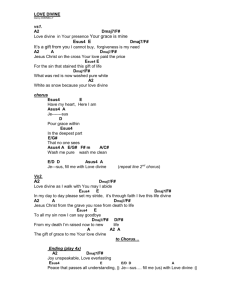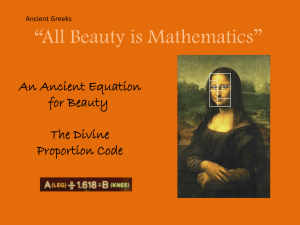INTRODUCTION
advertisement
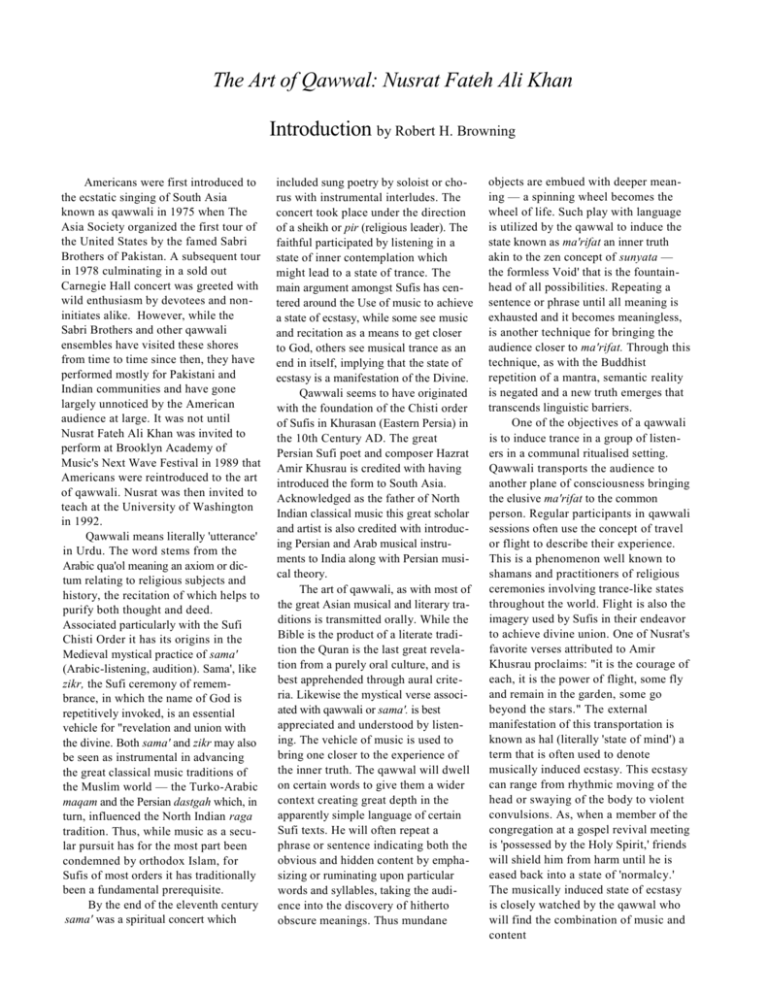
The Art of Qawwal: Nusrat Fateh Ali Khan Introduction by Robert H. Browning Americans were first introduced to the ecstatic singing of South Asia known as qawwali in 1975 when The Asia Society organized the first tour of the United States by the famed Sabri Brothers of Pakistan. A subsequent tour in 1978 culminating in a sold out Carnegie Hall concert was greeted with wild enthusiasm by devotees and noninitiates alike. However, while the Sabri Brothers and other qawwali ensembles have visited these shores from time to time since then, they have performed mostly for Pakistani and Indian communities and have gone largely unnoticed by the American audience at large. It was not until Nusrat Fateh Ali Khan was invited to perform at Brooklyn Academy of Music's Next Wave Festival in 1989 that Americans were reintroduced to the art of qawwali. Nusrat was then invited to teach at the University of Washington in 1992. Qawwali means literally 'utterance' in Urdu. The word stems from the Arabic qua'ol meaning an axiom or dictum relating to religious subjects and history, the recitation of which helps to purify both thought and deed. Associated particularly with the Sufi Chisti Order it has its origins in the Medieval mystical practice of sama' (Arabic-listening, audition). Sama', like zikr, the Sufi ceremony of remembrance, in which the name of God is repetitively invoked, is an essential vehicle for "revelation and union with the divine. Both sama' and zikr may also be seen as instrumental in advancing the great classical music traditions of the Muslim world — the Turko-Arabic maqam and the Persian dastgah which, in turn, influenced the North Indian raga tradition. Thus, while music as a secular pursuit has for the most part been condemned by orthodox Islam, for Sufis of most orders it has traditionally been a fundamental prerequisite. By the end of the eleventh century sama' was a spiritual concert which included sung poetry by soloist or chorus with instrumental interludes. The concert took place under the direction of a sheikh or pir (religious leader). The faithful participated by listening in a state of inner contemplation which might lead to a state of trance. The main argument amongst Sufis has centered around the Use of music to achieve a state of ecstasy, while some see music and recitation as a means to get closer to God, others see musical trance as an end in itself, implying that the state of ecstasy is a manifestation of the Divine. Qawwali seems to have originated with the foundation of the Chisti order of Sufis in Khurasan (Eastern Persia) in the 10th Century AD. The great Persian Sufi poet and composer Hazrat Amir Khusrau is credited with having introduced the form to South Asia. Acknowledged as the father of North Indian classical music this great scholar and artist is also credited with introducing Persian and Arab musical instruments to India along with Persian musical theory. The art of qawwali, as with most of the great Asian musical and literary traditions is transmitted orally. While the Bible is the product of a literate tradition the Quran is the last great revelation from a purely oral culture, and is best apprehended through aural criteria. Likewise the mystical verse associated with qawwali or sama'. is best appreciated and understood by listening. The vehicle of music is used to bring one closer to the experience of the inner truth. The qawwal will dwell on certain words to give them a wider context creating great depth in the apparently simple language of certain Sufi texts. He will often repeat a phrase or sentence indicating both the obvious and hidden content by emphasizing or ruminating upon particular words and syllables, taking the audience into the discovery of hitherto obscure meanings. Thus mundane objects are embued with deeper meaning — a spinning wheel becomes the wheel of life. Such play with language is utilized by the qawwal to induce the state known as ma'rifat an inner truth akin to the zen concept of sunyata — the formless Void' that is the fountainhead of all possibilities. Repeating a sentence or phrase until all meaning is exhausted and it becomes meaningless, is another technique for bringing the audience closer to ma'rifat. Through this technique, as with the Buddhist repetition of a mantra, semantic reality is negated and a new truth emerges that transcends linguistic barriers. One of the objectives of a qawwali is to induce trance in a group of listeners in a communal ritualised setting. Qawwali transports the audience to another plane of consciousness bringing the elusive ma'rifat to the common person. Regular participants in qawwali sessions often use the concept of travel or flight to describe their experience. This is a phenomenon well known to shamans and practitioners of religious ceremonies involving trance-like states throughout the world. Flight is also the imagery used by Sufis in their endeavor to achieve divine union. One of Nusrat's favorite verses attributed to Amir Khusrau proclaims: "it is the courage of each, it is the power of flight, some fly and remain in the garden, some go beyond the stars." The external manifestation of this transportation is known as hal (literally 'state of mind') a term that is often used to denote musically induced ecstasy. This ecstasy can range from rhythmic moving of the head or swaying of the body to violent convulsions. As, when a member of the congregation at a gospel revival meeting is 'possessed by the Holy Spirit,' friends will shield him from harm until he is eased back into a state of 'normalcy.' The musically induced state of ecstasy is closely watched by the qawwal who will find the combination of music and content responsible for the state repeating it with increasing intensity until a climax is reached, often creating enough resonance to pull in other members of the audience. The great masters of qawwal are able to move entire audiences to a hal even if they do not understand a single word of the language Westerners not conversant with mystical poetry may be confused by the seeming erotic or romantic nature of qawwali songs. Essentially, as A. W. Sadler has pointed out, the lyrics of the qawwals are in the style of the biblical song of songs. When a qawwal sings of the love of man for woman and woman for man he is celebrating divine love through allegory. The reference is to the selfless love of Cod for humankind and humankind for God. Yet the profane world is never denied — for what is human is divine and what is divine is human. To the puritan the notion of the sacred and profane being 'two sides of the same coin' is unacceptable to those who participate in gospel services or in the various Afro-Caribbean syncretic religious ceremonies, however, it is perfectly normal. The analogy of qawwali to African-American gospel is valid in more ways than one, for out of both idioms a secular form has evolved. American soul music grew out of the music of the African-American church,-, in recent years qawwali-style music, albeit with different (contemporary) lyrics may be heard in movies as disco or as background music for television, theater and radio throughout the Indian subcontinent. Nusrat's own experiments with Western artists such as Peter Gabriel and Jan Garbarek have contributed further to the influence that qawwali is having on other musical and extra-musical genres. It is rare, however, that these secular forms of the music achieve the power of qawwali in its traditional format. Even if one does not know the language being sung it is difficult not to be moved by this expression of devotion especially if one is in the presence of initiates who are fully conversant with the texts. These texts are taken mostly from the great Medieval Persian mystical poets such as Amir Khusrau, Hafiz Nizam ud Din Auliya and from local poets such as Bulleh Shah (Punjab—18th Century). Rarely is a complete poem recited-rather the singer will join segments from different poems or add lines from another text to emphasize a point or change the meaning. As has been mentioned, many of these poems are allegorical and charged with symbolism. The often used term 'Beloved' refers to divine love (for God or his Prophet). Terms such as 'face' and 'tresses' signify the spiritual qualities of the master,- building a 'house' signifies the pursuit of material well-being. Much use is made of such terms as 'wine' and 'tavern'. 'Wine' is the knowledge and love of God which intoxicates the initiate. The 'tavern' refers to the spiritual master or Sheikh, whose heart is said to be the repository of God's love. Qawwali is essentially a folk art. While Hindi film music and Western pop have both had an enormous impact in South Asia, qawwali remains immensely popular in Pakistan. Nusrat Fateh Ali Khan's contribution to its continued popularity is considerable. Perhaps more than any other artist he has united the great classical tradition of the Subcontinent with simple folk songs appealing to a wide cross section of people. Robert H. Browning is the Artistic and Executive Director at World Music Institute.
